北师大高中英语全英文说课稿
北师大高中英语全英文说课稿
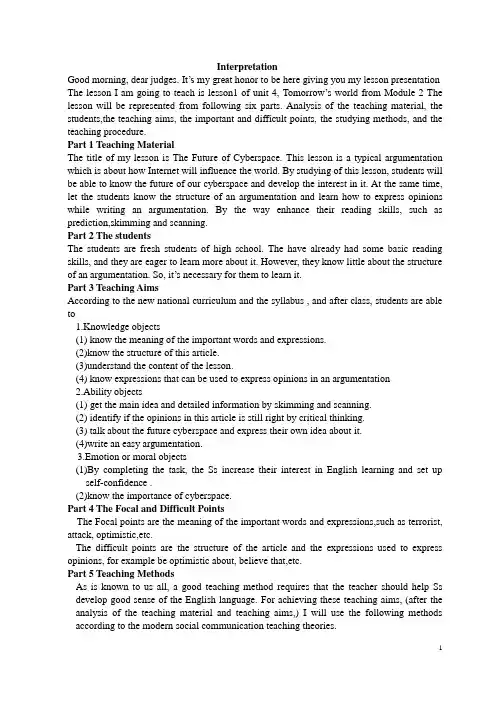
InterpretationGood morning, dear judges. It’s my great honor to be here giving you my lesson presentation The lesson I am going to teach is lesson1 of unit 4, Tomorrow’s world from Module 2 The lesson will be represented from following six parts. Analysis of the teaching material, the students,the teaching aims, the important and difficult points, the studying methods, and the teaching procedure.Part 1 Teaching MaterialThe title of my lesson is The Future of Cyberspace. This lesson is a typical argumentation which is about how Internet will influence the world. By studying of this lesson, students will be able to know the future of our cyberspace and develop the interest in it. At the same time, let the students know the structure of an argumentation and learn how to express opinions while writing an argumentation. By the way enhance their reading skills, such as prediction,skimming and scanning.Part 2 The studentsThe students are fresh students of high school. The have already had some basic reading skills, and they are eager to learn more about it. However, they know little about the structure of an argumentation. So, it’s necessary for them to learn it.Part 3 Teaching AimsAccording to the new national curriculum and the syllabus , and after class, students are able to1.Knowledge objects(1) know the meaning of the important words and expressions.(2)know the structure of this article.(3)understand the content of the lesson.(4) know expressions that can be used to express opinions in an argumentation2.Ability objects(1) get the main idea and detailed information by skimming and scanning.(2) identify if the opinions in this article is still right by critical thinking.(3) talk about the future cyberspace and express their own idea about it.(4)write an easy argumentation.3.Emotion or moral objects(1)By completing the task, the Ss increase their interest in English learning and set upself-confidence .(2)know the importance of cyberspace.Part 4 The Focal and Difficult PointsThe Focal points are the meaning of the important words and expressions,such as terrorist, attack, optimistic,etc.The difficult points are the structure of the article and the expressions used to express opinions, for example be optimistic about, believe that,etc.Part 5 Teaching MethodsAs is known to us all, a good teaching method requires that the teacher should help Ss develop good sense of the English language. For achieving these teaching aims, (after the analysis of the teaching material and teaching aims,) I will use the following methods according to the modern social communication teaching theories.1municative Approach2.Whole Language Teaching3.Task-based Language Teaching4.“Scene —Activity”Teaching method , it establishes a real scene and the interactionbetween the teacher and the Ss.2Step 5. Homeworkplete your argumentation “The Future of Cyberspace.Purpose of my design: Homework is so important and necessary for to master the knowledge they learned after class. It will check whether the Ss achieve the teaching aims. Reflection:3。
北师大高中英语必修一Unit1Lesson1说课稿

Interpretation of Lesson 1 A Perfect Day?Part 1 Teaching Material:The basic topic of this unit is “lifestyles”.Lesson1 plays an important part in this unit. The articles,titles are that “A couch potato”and “A workaholic”. These two articles present completely different lifestyles. There are two pictures to stir students? interest. The first article is talking about one person who spends too much time watching TV. The second article is related with the other person who is always working from morning to night. After reading, weall know that one person is a couch potato;the other person is a workaholic.Writing purpose is that: Tell the readers these two kinds of lifestyle are unhealthy. Try to make the readers pay attention to healthy lifestyle and lead a rich life.Teaching aims1.Knowledge aims:The Ss can remember and use the topic vocabulary and topic sentences.2.Ability aims:Enable the students to understand specific information while reading.Enable the students to work out the meaning of important words from the context.Enable the students to Present Simple and Present Continuous.3.Emotional aims:Help the students have an idea that we should lead a healthy life.Teaching focus:A. Important points:1. To discuss favorite TV programs and daily activities and to read two texts forspecific information2. Improve the Ss? reading abilityB. Difficult points:1. To revise Present Simple and Present ContinuousWell, how to achieve the teaching objectives better, to stress the key points and break through the difficult points? The key is how to make use of the proper teaching methods. I?ll talk about my teaching methods below.Part 2: Teaching methods:According to the modern perception theories and social intercourse teaching theories, I adopt theTSA method and TBLT method in my teaching, namely Total Situational Action and Task-based Language Teaching.The former is a “scene —activity” teaching method .It establishes a real scene and the interaction between the teacher and the Ss .It emphasizes a dynamic information exchange between the teacher and Ss.The latter offers the Ss an opportunity to complete the tasks in which Ss use language to achieve a specific outcome. Let the Ss know more about life while they are learning English. As a guide,teacher should make the Ss use English freely and correctly. And combine the language structures with language functions.Finally, student-centered teaching method, free discussion, individual work, pair work, group work. Fast-reading, careful-reading, and presentation.Part 3: Learning methods:The Ss do not often use English to express themselves and communicate with others. Some Ss are not active in the class, because they are afraid of making mistakes. Let Ss study in a relaxed and agreeable atmosphere. Ss understand the new knowledge in certain degree through the mental process of seeing, hearing, saying, observing, imagining, thinking etc. So let Ss make preparationsfor completing the new study task.After feeling and comprehending the language points, let Ss obtain the knowledge actively by cooperative study. Thereby, develop the Ss? a bilities of studying and working with the learning language independently.Part 4: Teaching aids:A blackboard, a projector or computerPart 5: Teaching proceduresStep 1: Lead-in and pre-reading:T: I think most of us like watching TV. Watching TV is part of our life, do you think so?S:T: We know about all kinds of things from TV. What are your favorite kinds of TV program? Tell the class. Use the Key Words to help you. (Show some slides about TV programs)S:T: Why do you like the programs?S:T: Do you ever watch too much TV? How much time do you spend watching TV every day?S:T: The way a person lives and works is different. Can you imagine an adult doesnothing except watch TV all day? Or he only thinks of working and never has time to watch TV? What kind of lifestyle do you think the men in the picture have?S:T: In reality few people like do that, but some people like that lifestyle and think it is a perfect day. Now let?s read the text “A Perfect Day?” really?Step 2: Fast-readingDo the exercise 3 to let students understand the text.Read the two texts quickly and underline the TV programs that Brain usually watches.The children?s programs, news, old movies, TV series, ports gamesUnderline the kinds of work Bob does every day.Meetings and phone calls, urgent matters, do my own paperwork and answer some personal e-mails, l ook at documents at home, be ready for the next day?s workStep 3: Careful-reading:Do the exercise 4. Read the two texts again and answer these questions. First let the students look through five questions. Then read the text again carefully. Think about the following five questions. When you finish your reading, I will check your answers. After that, Ss have got a better understanding of this article. Then guide the Ss to summarize main idea of each paragraph. This part reflects Task-based Language Teaching. And enable the students to understand specific information while reading.Step 4:Presentation --DiscussionWhich lifestyle do you prefer? Which one is healthier?What can Bob or Brian do to improve their lifestyle?Possible answers:Do you work too hard? You may need more time to enjoy your life with your family.You are too lazy! Your life is too boring only at home .You should go out for workand do some exercise.(Up to now, it is one period)Step 5: Post-reading and word studyAfter analyzing the text, I think all of you have a deeper thought of the passage. Now we will do some exercises. Complete exercise 7on page 9.Then give the students some time to finish the exercise. Some time later, check the answers. If possible, ask the students to translate the sentences into Chinese.Then I will explain key words. Such as: switch on; take up, fill with …Step 6: GrammarDo the exercise 8 and 9.To revise Present Simple and Present Continuous.Step 7: PracticeLet Ss do some exercises to consolidate what we learnt just now. Look at task ten. Read this sentence, describe your parents? lifestyles to your partner.Step 8: Blackboard DesignA Perfect Day?Main idea of each para. Grammar Language pointsswitch ontake up….Step 9 HomeworkKeep a diary about your weekend.That is all for my interpretation. Thank you for your attention.。
北师大英语必修1说课稿
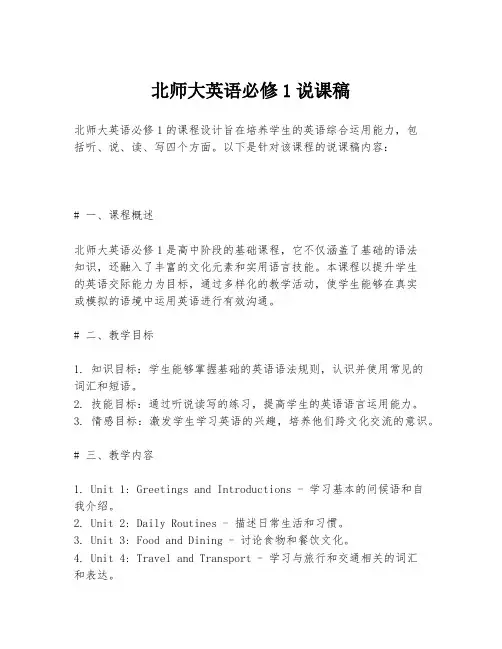
北师大英语必修1说课稿北师大英语必修1的课程设计旨在培养学生的英语综合运用能力,包括听、说、读、写四个方面。
以下是针对该课程的说课稿内容:# 一、课程概述北师大英语必修1是高中阶段的基础课程,它不仅涵盖了基础的语法知识,还融入了丰富的文化元素和实用语言技能。
本课程以提升学生的英语交际能力为目标,通过多样化的教学活动,使学生能够在真实或模拟的语境中运用英语进行有效沟通。
# 二、教学目标1. 知识目标:学生能够掌握基础的英语语法规则,认识并使用常见的词汇和短语。
2. 技能目标:通过听说读写的练习,提高学生的英语语言运用能力。
3. 情感目标:激发学生学习英语的兴趣,培养他们跨文化交流的意识。
# 三、教学内容1. Unit 1: Greetings and Introductions - 学习基本的问候语和自我介绍。
2. Unit 2: Daily Routines - 描述日常生活和习惯。
3. Unit 3: Food and Dining - 讨论食物和餐饮文化。
4. Unit 4: Travel and Transport - 学习与旅行和交通相关的词汇和表达。
5. Unit 5: School Life - 探讨学校生活和学习经验。
# 四、教学方法1. 情景教学法:通过模拟真实情景,让学生在实际语境中学习和使用英语。
2. 任务型教学法:设计各种任务,鼓励学生通过合作完成,提高语言实践能力。
3. 交际教学法:强调语言的交际功能,鼓励学生在交流中学习语言。
# 五、教学过程1. 导入阶段:通过多媒体材料或互动游戏引入新话题,激发学生兴趣。
2. 呈现阶段:清晰展示新词汇、语法结构和语言功能。
3. 练习阶段:通过小组讨论、角色扮演等活动,让学生实践所学知识。
4. 产出阶段:设计写作或口头报告任务,让学生展示学习成果。
5. 反馈阶段:及时给予学生正面反馈和建设性建议。
# 六、教学评价1. 形成性评价:通过课堂参与度、小组活动表现等进行评价。
北师大版高中高一英语必修2《Lesson4Let’s…》说课稿
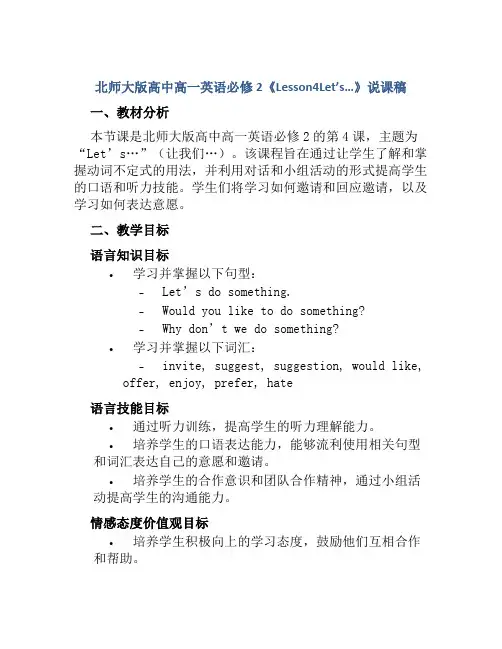
北师大版高中高一英语必修2《Lesson4Let’s…》说课稿一、教材分析本节课是北师大版高中高一英语必修2的第4课,主题为“Let’s…”(让我们…)。
该课程旨在通过让学生了解和掌握动词不定式的用法,并利用对话和小组活动的形式提高学生的口语和听力技能。
学生们将学习如何邀请和回应邀请,以及学习如何表达意愿。
二、教学目标语言知识目标•学习并掌握以下句型:–Let’s do something.–Would you like to do something?–Why don’t we do something?•学习并掌握以下词汇:–invite, suggest, suggestion, would like, offer, enjoy, prefer, hate语言技能目标•通过听力训练,提高学生的听力理解能力。
•培养学生的口语表达能力,能够流利使用相关句型和词汇表达自己的意愿和邀请。
•培养学生的合作意识和团队合作精神,通过小组活动提高学生的沟通能力。
情感态度价值观目标•培养学生积极向上的学习态度,鼓励他们互相合作和帮助。
•培养学生的社交能力,使他们能够主动邀请他人并礼貌地回应邀请。
三、教学重点和难点教学重点•了解和掌握动词不定式的用法及相关句型。
•提高学生的口语和听力能力,培养他们表达意愿和邀请的能力。
教学难点•学生对动词不定式的用法理解和运用的准确性。
•学生如何合理组织句子,流利地表达自己的意愿和邀请。
四、教学过程步骤一:导入与热身(10分钟)•通过播放一段英文歌曲,让学生放松身心,进入学习状态。
•引导学生回忆上一节课掌握的表达意愿的句型,与学生进行简短的问答交流。
步骤二:呈现新知(20分钟)•展示一些图片和单词,引导学生学习新的词汇。
例如,invite, suggest, suggestion, would like, offer, enjoy, prefer, hate。
•引导学生听录音,并根据所听到的信息完成相关练习,培养学生的听力理解能力。
北师大版英语高中说课稿
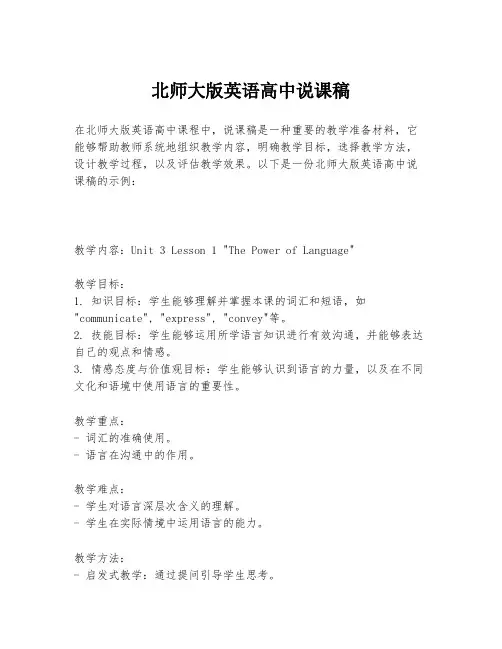
北师大版英语高中说课稿在北师大版英语高中课程中,说课稿是一种重要的教学准备材料,它能够帮助教师系统地组织教学内容,明确教学目标,选择教学方法,设计教学过程,以及评估教学效果。
以下是一份北师大版英语高中说课稿的示例:教学内容:Unit 3 Lesson 1 "The Power of Language"教学目标:1. 知识目标:学生能够理解并掌握本课的词汇和短语,如"communicate", "express", "convey"等。
2. 技能目标:学生能够运用所学语言知识进行有效沟通,并能够表达自己的观点和情感。
3. 情感态度与价值观目标:学生能够认识到语言的力量,以及在不同文化和语境中使用语言的重要性。
教学重点:- 词汇的准确使用。
- 语言在沟通中的作用。
教学难点:- 学生对语言深层次含义的理解。
- 学生在实际情境中运用语言的能力。
教学方法:- 启发式教学:通过提问引导学生思考。
- 合作学习:分组讨论,共同完成语言实践任务。
- 情景模拟:设置不同的语言使用场景,让学生实践语言的应用。
教学过程:1. 导入(Lead-in):通过展示不同语言的问候语,激发学生对语言多样性的兴趣。
2. 呈现(Presentation):介绍新词汇和短语,通过图片、例句等多种形式帮助学生理解。
3. 练习(Practice):学生通过填空、匹配等练习形式,巩固新词汇和短语。
4. 应用(Application):分组进行角色扮演,模拟不同场景下的沟通。
5. 产出(Production):学生独立或小组形式,就某一话题进行讨论,并用英语表达自己的观点。
6. 总结(Summary):回顾本课所学内容,强调语言在沟通中的重要性。
作业布置:- 完成课后练习册中的相关习题。
- 准备一个简短的演讲,主题为“语言的力量”。
教学反思:- 反思学生在课堂上的参与度和互动情况。
北师大高一英语说课稿
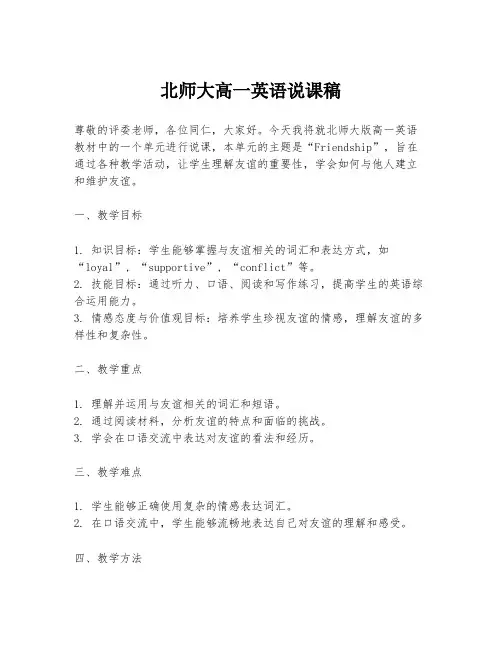
北师大高一英语说课稿尊敬的评委老师,各位同仁,大家好。
今天我将就北师大版高一英语教材中的一个单元进行说课,本单元的主题是“Friendship”,旨在通过各种教学活动,让学生理解友谊的重要性,学会如何与他人建立和维护友谊。
一、教学目标1. 知识目标:学生能够掌握与友谊相关的词汇和表达方式,如“loyal”, “supportive”, “conflict”等。
2. 技能目标:通过听力、口语、阅读和写作练习,提高学生的英语综合运用能力。
3. 情感态度与价值观目标:培养学生珍视友谊的情感,理解友谊的多样性和复杂性。
二、教学重点1. 理解并运用与友谊相关的词汇和短语。
2. 通过阅读材料,分析友谊的特点和面临的挑战。
3. 学会在口语交流中表达对友谊的看法和经历。
三、教学难点1. 学生能够正确使用复杂的情感表达词汇。
2. 在口语交流中,学生能够流畅地表达自己对友谊的理解和感受。
四、教学方法1. 情景教学法:通过设置与友谊相关的情境,让学生在实际语境中学习和使用语言。
2. 合作学习法:鼓励学生分组讨论,共同完成与友谊相关的任务。
3. 任务型教学法:设计任务驱动型活动,让学生在完成任务的过程中学习语言。
五、教学过程1. 导入(Lead-in):- 通过展示一些关于友谊的图片或视频,激发学生对友谊话题的兴趣。
- 提问学生关于友谊的看法,激活学生已有的背景知识。
2. 呈现(Presentation):- 介绍与友谊相关的词汇和短语,通过例句让学生理解其用法。
- 播放一段关于友谊的听力材料,让学生初步了解材料内容。
3. 练习(Practice):- 分组进行角色扮演,模拟不同情境下的友谊对话。
- 完成与友谊相关的填空、匹配等练习题,巩固词汇和语法。
4. 应用(Application):- 阅读一篇关于友谊的文章,分析文章中友谊的特点和挑战。
- 组织小组讨论,让学生分享自己的友谊故事和对友谊的理解。
5. 产出(Production):- 让学生写一篇短文,描述自己的一个友谊经历或对友谊的看法。
北师大版高中高一英语必修2《Lesson 2 Great Inventions》说课稿
北师大版高中高一英语必修2《Lesson 2: Great Inventions》说课稿一、教材分析教材信息•课文名称:Great Inventions•课文类型:科普类文章•课文作者:Unkown•课文长度:约600字•难度等级:适合高中高一学生阅读•主题:介绍一些伟大的发明教学目标知识目标•学习并掌握一些重要的科学发明的名称和背后的故事•掌握一些与发明相关的词汇和表达方式•了解科学发明对人类社会的影响和意义能力目标•培养学生的阅读理解能力,能够理解科普类文章的主要内容和细节•提高学生的听说能力,能够在小组或全班中进行发言和讨论•培养学生的创新思维和科学探索精神情感目标•通过学习伟大发明的故事,激发学生的探索和学习兴趣•培养学生的创造力和独立思考能力•培养学生对科学与技术的热爱和敬畏之心二、教学重点与难点教学重点•学习和运用与发明相关的词汇和表达方式•理解文章的主旨和细节教学难点•学生对于一些科学概念的理解和表达•文章中的长难句的理解和拆解三、教学准备•教材:北师大版高中英语必修2•多媒体设备•单词卡片和短语卡片•小组讨论问题准备四、教学过程导入(5分钟)1.利用多媒体设备播放一段与发明相关的视频或展示一些有趣的发明品图片,引发学生对科学发明的兴趣,并与学生进行简要的讨论。
预测与探究(10分钟)1.引导学生观察课文标题和图片,预测文章的主题,并简要讨论一下。
2.学生阅读课文第一段,讨论以下问题:–What do we learn about inventions from the first paragraph?–Can you think of any other great inventions?–Why are inventions important?阅读与理解(15分钟)1.学生们在课本上阅读全文,并完成与文章主旨和细节相关的练习题。
2.教师提问并引导学生回答以下问题:–What are some great inventions mentioned in the text?–Why do you think these inventions are considered great?–How have these inventions changed the way we live?–Can you think of any other inventions that have had a big impact on society?–How do you think future inventions will affect our lives?词汇与拓展(15分钟)1.教师带领学生学习文章中一些重要的词汇和短语,例如:–invention–invent–inventor–experiment–discovery–transform–impact–revolutionize–significant2.学生们分组合作,使用这些词汇和短语造句,并与全班分享。
北师大版高中英语必修一unit1 lesson1说课稿
Unit 1 LifestylesLesson 1 A Perfect Day? 阅读课说课稿Good morning, dear judges. I am contestant No. 6. It’s my great honor to share my teaching with you. Today my teaching topic is “Lesson 1 A Perfect Day?”. I am going to introduce my lesson from the following aspects:1. Analysis of teaching materialsThis lesson is from Senior high school English compulsory 1 of Beijing Normal University Press,unit one, lesson one—A Perfect Day? This lesson is about two different lifestyles—a couch potato and a workaholic. Through the study of this lesson, students can be aware that we should form good habits and healthy lifestyles.2. Analysis of studentsOur students are Senior high school students from the first grade. They are interested in the new topic. After many years of English learning, they’ve known many words, sentences and some skills to solve English problems. But they can’t use it to express themselves and communicate with others fluently. So in this period, I would arrange a variety of activities to help them take part in the class and improve their language using abilities.3. Analysis of teaching aimsBased on the English curriculum standard and the charasteristics of the students, I set the following teaching aims:(1) Knowledge aims:Students can understand the titles a couch potato and a workaholic.They will understand the main idea and some specific points of the passage and grasp the reading strategies of skimming and scanning.(2) Ability aims:Students will express their opinions on different lifestyles under the teacher’s guidance and use different reading strategies to get specific information in a limited time.(3) Emotional aims:Students will enhance their good habits and try to live a banlanced and healthy life.4. Analysis of teaching key points and difficult pointsThe key points are the understanding of the main idea and some specific points of the passage and the master of important reading strategies.The difficult points are how to arouse students’ awareness of forming good habits and living a healthy life and how to enable the students to use different strategies proficiently.5. Analysis of teaching methods and learning methodsTo help students achieve the teaching aims much better and easier,I’ll mainly use “Task-based” and “Communicative” teaching methods. For students, they will be encouraged to study by themselves, and they will learn to communicate with others through pair work and group work, and become the real host of the class.6. Analysis of teaching aidsIn order to catch students’ attention, I prepare multi-media and some video clips, pictures and charts.7. Analysis of teaching proceduresThis is the most important part in this design, and it can be divided into the following steps:Step 1 Warming-up and lead inAt the beginning of class I will greet students as usual, have a short free talk with them and then ask students to sing a song together with me. In this way students will become happy and excited, and their attention will be attracted into class activities and get ready for class. Next I will announce the beginning of class and tell them the new topic Lesson 1 A Perfect Day? And of course I will write the new topic on the blackboard immediately.Step 2 Pre-readingBefore reading I will have a free talk about watching TV with students, and encourage them to make predictions according to the title and pictures in the book. And I will explain some new words like a couchpotato and a workholic. By doing these, students are able to overcome the obstacles of new words in the passage and make the following reading steps go smoothly. Through predictions students can quickly move their attention to the reading part.Step 3 While-readingFor the while-reading. First, students should do fast reading, I will ask them to read the two texts quickly and try to finish the following tasks: 1. Underline the TV programmes that Brian usually watches. 2. Underline the kinds of work that Bob does every day. Three minutes later, I will ask some students to tell me the answers. (Brian usually watches children’s programmes and old movies in the morning. And he watches the news at lunch time. He watches old films in the afternoon. And in the evening he watches TV series or sport and the news again. He also watches plays on BBC2 and more films. Bob is always very busy with meetings and phone calls, and some other urgent matters. And in the evening he has to do some paperwork and answer personal e-mails. And about ten every night he usually looks at the documents that he bring back from the office to get ready for the next day’s work. )For second reading, I will ask students to answer five questions:1.Is Brian a lazy person? Can you find two examples of his lazy behaviour?2.What do you think “You’ve got the world at your feet.”means?3.How does Bob spend his morning and evening?4.Why does Bob’s family complain?5.Why does Bob work so hard?I will give students 8 minutes, and 8 minutes later, I will choose some students to answer my questions one by one.(Yes, Brian is a lazy person. He watches TV 16 or 17 hours a day. When he walks the dog, he doesn’t go far. And he takes his portable TV and sits on a stone wall while the dog walks round in a circle. So , Bob is really lazy.“You’ve got the world at your feet.”means You are free to watch any programme that you want to watch. You can use the remote control to make choices accordingly.Yes, Bob is always busy. In the early morning when he hears the alarm clock he jumps out of his bed, and begins to get ready for his work. He takes a bus to work. All the morning he is busy with meetings and phone calls. And in the evening he looks at some documents he brings back from the office to get ready for the next day’s work.Because he is always busy with his work and seldom has time for fun and other activities with his family.Bob works so hard that he can make more money for his family. ) Step 4 Post-readingThrough the above readings students can get the key points of thislesson, so I would like to organize a pair work and a group work to improve their communicative ability.For pair work, I will ask students to join in pairs and ask each other these questions in turn, What do you do at weekends? Do you often study at weekends? Decide whether your partner is a couch potato or a workaholic or neither. 3 minutes later, I will choose some pairs to share their performance.For group work, students need to work in groups of 4 and discuss these questions: Are Brian and Bob’s lifestyles healthy? What can they do to improve their lifestyles? Each group leader should collect suggestions and five minutes later I will ask some group leaders to give an oral report. So this discussion can achieve the emotional aims of arousing their awareness of forming good habits and a healthy lifestyle.Step 5 Summary and homeworkAfter all the activities I will help students to review the two kinds of lifestyles they have learned today.For homework, I will ask students to listen to the recording of the texts for three to five times and read after them and try to retell the texts in their own words. And at the beginning of next class I will ask some students to retell the texts.8. Analysis of blackboard designMy blackboard design is like this. It can make clear the important information of this lesson and help students to make the notes.That’s all for my presentation. Thank you for your listening.。
高中英语说课稿范文英文版北师大版(合集6篇)
高中英语说课稿范文英文版北师大版(合集6篇)(经典版)编制人:__________________审核人:__________________审批人:__________________编制单位:__________________编制时间:____年____月____日序言下载提示:该文档是本店铺精心编制而成的,希望大家下载后,能够帮助大家解决实际问题。
文档下载后可定制修改,请根据实际需要进行调整和使用,谢谢!并且,本店铺为大家提供各种类型的经典范文,如工作总结、工作计划、合同协议、条据文书、策划方案、句子大全、作文大全、诗词歌赋、教案资料、其他范文等等,想了解不同范文格式和写法,敬请关注!Download tips: This document is carefully compiled by this editor. I hope that after you download it, it can help you solve practical problems. The document can be customized and modified after downloading, please adjust and use it according to actual needs, thank you!Moreover, our store provides various types of classic sample essays for everyone, such as work summaries, work plans, contract agreements, doctrinal documents, planning plans, complete sentences, complete compositions, poems, songs, teaching materials, and other sample essays. If you want to learn about different sample formats and writing methods, please stay tuned!高中英语说课稿范文英文版北师大版(合集6篇) 高中英语说课稿范文英文版北师大版第1篇First, based on the information from the teXt and the flow chart drawn in time order, students are asked to work in group of five and choose a group leader to act as the reporter who will interview the other four members, all of whom will act as the writer about their Christmas memories.Writer 1 will talk about her memories in November, writer 2 will talk about her memories in December, and the rest two will talk about their memories on Christmas Eve and Christmas Day.I will give some demo questions, for instance, when did Christmas begin for you, what did you do on Christmas Eve,and how did you feel on Christmas Day? And I will also provide some useful words for them, such as letter, presents and so on.Then I will invite two groups to role play before the whole class, and give some evaluations for their performance.This activity aims to develop students’ communicative skills and get them talk about Christmas to grasp the teXt better.高中英语说课稿范文英文版北师大版第2篇As far as teaching and learning methods are concerned, I’ll adopt communicative approach,task-based teaching andlearning approach,situational approach and cooperative approach.Different tasks and real conteXt will be given, and I will design some attractive and practical learning activities to get the students communicate and cooperate with each other.高中英语说课稿范文英文版北师大版第3篇Good morning, respected authorities, teachers, welcome to my class! First of all, I want to address my great honor to share some of my teaching ideas with all of you.Today, my teaching topic is Unit 3 Celebrations, Lesson 3 Memories of Christmas.For this lesson, my teaching plan will falls into seven parts.They are theoretical basis, analysis of teaching material and students, teaching objectives, teaching focuses,teaching difficulties,teaching and learning methods,teaching procedures,blackboard layout and teaching reflection.Now I will introduce them one by one高中英语说课稿范文英文版北师大版第4篇1.Teaching focusesAs we have seen,there are three focuses in this lesson.First, get the students acquire the factual information about the author’s Christmas eXperience.Second,create situations to guide them learn to talk about Christmas or their own festival memories.The last one is to help the studentsunderstand the cultural meanings of Christmas and learn to respect different cultures.2.DifficultiesAs for teaching difficulties, there may be difficulties in getting the students talk about Christmas or their own festival memories, understand the true meanings of Christmas in western culture, and learn to respect and love different cultures and arouse their patriotism.高中英语说课稿范文英文版北师大版第5篇Based on the core competencies, I’ll set my teaching objectives from these four aspects,language ability,thinking quality,cultural awareness and learning ability.Overall, by the end of this lesson, students will be able to :nguage ability: get the factual information about the writer’s ChristmaseXperience and memories with her granny, then work out the structure of the teXt to talk about Christmas and connect life to share their festival memories.2.Thinking quality: What’s more,students are also eXpected to cultivate theirability of critical, divergent and creative thinking.3.Cultural awareness: Then, they will understand the meanings of Christmas inwestern culture, learn to respect and love different cultures and arouse their love for family and enhance their self-confidence of our national culture.4.Learning ability: Finally, students will develop their abilities of independentLearning and cooperative learning.高中英语说课稿范文英文版北师大版第6篇1.Analysis of teaching materialAs we have seen, this is the whole structure of the contents of unit 3 celebrations.There are different teXt types in this unit, including listening, reading, writing and viewing.All of these small concepts of different teXts forms the big concept of unit 3 that is about helping students to learn about the celebrations of different festivals and occasions in different nations, and feeling the cultural connotations behind the celebrations, which is to form the core competencies and build up students’ self-confidence of national culture.The theme conteXt of unit 3 Celebrations is “man and society”, which involves history, society and culture.Lesson 3 Memories of Christmas is a narrative, I willanalyze it from these three perspectives, what, why and how.Firstly, the teXt is about an unforgettable Christmas eXperience and memories between the writer and her granny, and the writer’s feeling of missing for her grandma.Then, most of the students just have the superficial understandings of Christmas, but they are unable to master the spirit or the true meanings of Christmas in western culture.And this lesson will provide some specific introductions of Christmas and help the students to learn about its cultural stly, the story is told in the first person and it is narrated in time order to present some vivid pictures of the writer and her granny’s memories.2.Analysis of studentsAs we all know, this lesson is intended for senior one students, most of whom are from fifteen to seventeen.They have strong abilities of memorizing, imitating and performing, and they have got the basic abilities of listening, speaking,reading and writing.However, they are also different, less determined and relatively stressed.Thus,they still need proper attention and artful direction.。
北师大版高中英语必修一superhero说课稿
北师大版高中英语必修一superhero说课稿(总3页)-CAL-FENGHAI.-(YICAI)-CompanyOnel封面,使用请直接删除北师大版高中英语必修一第二单元第四课第一课时姓名:班级:学号:指导老师Unit2HeroesLesson4Superhero(说课稿)大家好,今天我说课的内容是北师大版高中英语必修一第二单元lesson4Superhero。
下面我将从教材分析、学情分析、教法学法、教学过程以及教学反思等五方面来展开。
一、教材分析1.本教材是北京师范大学出版社出版的普通高中课程标准实验教科书,本课是高一必修模块一第二单元第四课的阅读课型,本单元围绕“英雄”展开,涉及中西方文化中的许多英雄人物,内容丰富,十分重要。
本节课的教学思想是在英语教学中落实新课程标准,在教学过程中与学生积极互动,共同探讨,并且引导学生调查、探究,帮助学生掌握一定的阅读技巧,形成自主、合作的学习方法,使每个学生都能学有所得。
2.教学目标知识与技能:1)通过启发式阅读,学生能理解文章大意;2)掌握与主题有关的一些词汇,表达方式;3)学生的阅读技能可以得到提高。
过程与方法:通过课堂活动,学生自主以及合作解决问题的能力得以提高,创新思维能力得到发展。
情感态度与价值观:通过对现实生活中的superhero及其事迹的学习,培养学生顽强不屈应对各种挑战的精神。
3.重难点重点:重点词汇及表达方式的掌握;通过快速阅读掌握文章大意,解决问题难点:熟练运用英语表达看法,交流观点。
二、学情分析优点:大多数学生来自较优秀的中学,基础好,基本功扎实;对本课主题很感兴趣,有深入了解的欲望缺点:创新能力不强,快速反应能力较差三、教法学法教法:根据当前的教学改革尤其是课程改革的先进理念,以及高一学生的知识和能力水平,为达成前面所说的教学目标,我认为应采用任务教学法、交际教学法、愉悦教学法相结合的形式展开教学,这里所提到的每一种教学方法都不是孤立存在的,它们的有机结合能充分调动学生的学习积极性,能收到良好的效果。
- 1、下载文档前请自行甄别文档内容的完整性,平台不提供额外的编辑、内容补充、找答案等附加服务。
- 2、"仅部分预览"的文档,不可在线预览部分如存在完整性等问题,可反馈申请退款(可完整预览的文档不适用该条件!)。
- 3、如文档侵犯您的权益,请联系客服反馈,我们会尽快为您处理(人工客服工作时间:9:00-18:30)。
Interpretation
Good morning, dear judges. It’s my great honor to be here giving you my lesson presentation
The lesson I am going to teach is lesson1 of unit 4, Tomorrow’s world from Module 2 The lesson will be represented from following six parts. Analysis of
the teaching material, the students,the teaching aims, the important and difficult points, the studying methods, and the teaching procedure.
Part 1 Teaching Material
The title of my lesson is The Future of Cyberspace. This lesson is a typical argumentation which is about how Internet will influence the world. By studying
of this lesson, students will be able to know the future of our cyberspace and develop the interest in it. At the same time, let the students know the structure
of an argumentation and learn how to express opinions while writing an argumentation. By the way enhance their reading skills, such as prediction,skimming and scanning.
Part 2 The students
The students are fresh students of high school. The have already had some basic reading skills, and they are eager to learn more about it. However, they know little about the structure of an argumentation. So, it’s necessary for them to learn it.
Part 3 Teaching Aims
According to the new national curriculum and the syllabus , and after class, students are able to
objects
(1) know the meaning of the important words and expressions.
(2)know the structure of this article.
(3)understand the content of the lesson.
(4) know expressions that can be used to express opinions in an argumentation
objects
(1) get the main idea and detailed information by skimming and scanning.
(2) identify if the opinions in this article is still right by critical thinking.
(3) talk about the future cyberspace and express their own idea about it.
(4)write an easy argumentation.
or moral objects
(1)By completing the task, the Ss increase their interest in English learning and set up self-confidence .
(2)know the importance of cyberspace.
Part 4 The Focal and Difficult Points
The Focal points are the meaning of the important words and expressions,such
as terrorist, attack, optimistic,etc.
The difficult points are the structure of the article and the expressions used to express opinions, for example be optimistic about, believe that,etc.
Part 5 Teaching Methods
As is known to us all, a good teaching method requires that the teacher should help Ss develop good sense of the English language. For achieving these teaching aims, (after the analysis of the teaching material and teaching aims,) I will use the following methods according to the modern social communication teaching theories.
municative Approach
2.Whole Language Teaching
3.Task-based Language Teaching
4.“Scene — Activity” Teaching method , it establishes a real
scene and the interaction between the teacher and the Ss.
Step 5. Homework
plete your argumentation “The Future of Cyberspace.
Purpose of my design: Homework is so important and necessary for to master the knowledge they learned after class. It will check whether the Ss achieve the teaching aims.
Reflection:。
